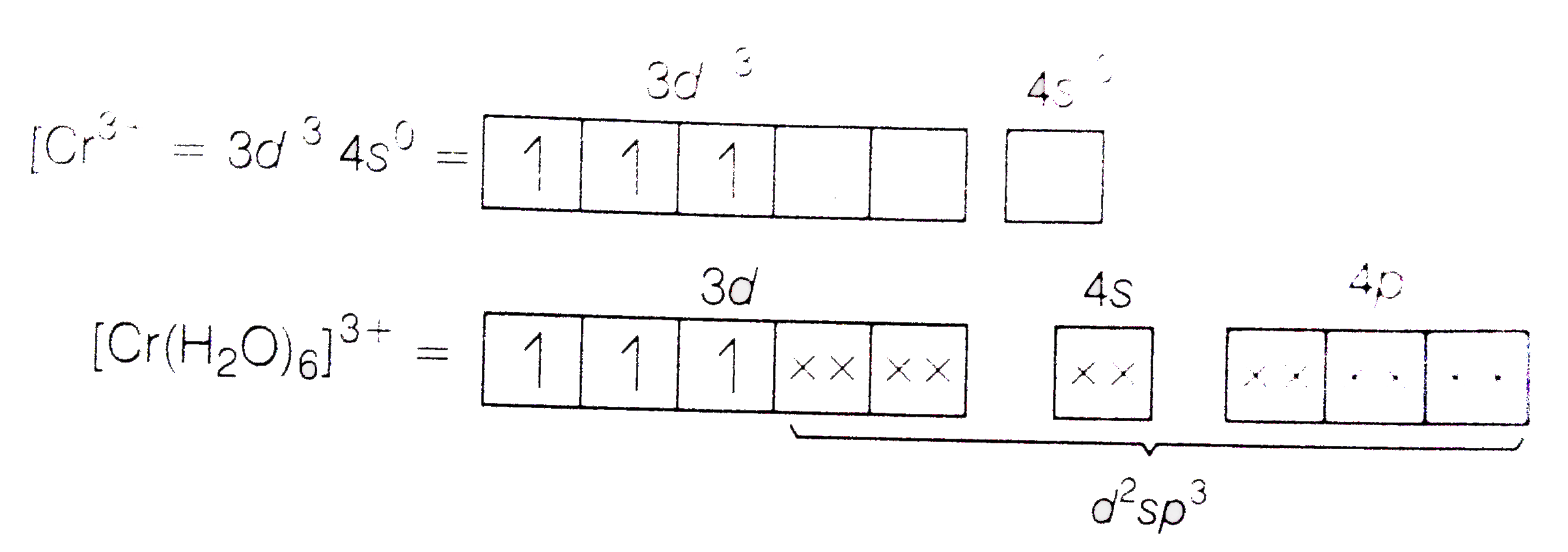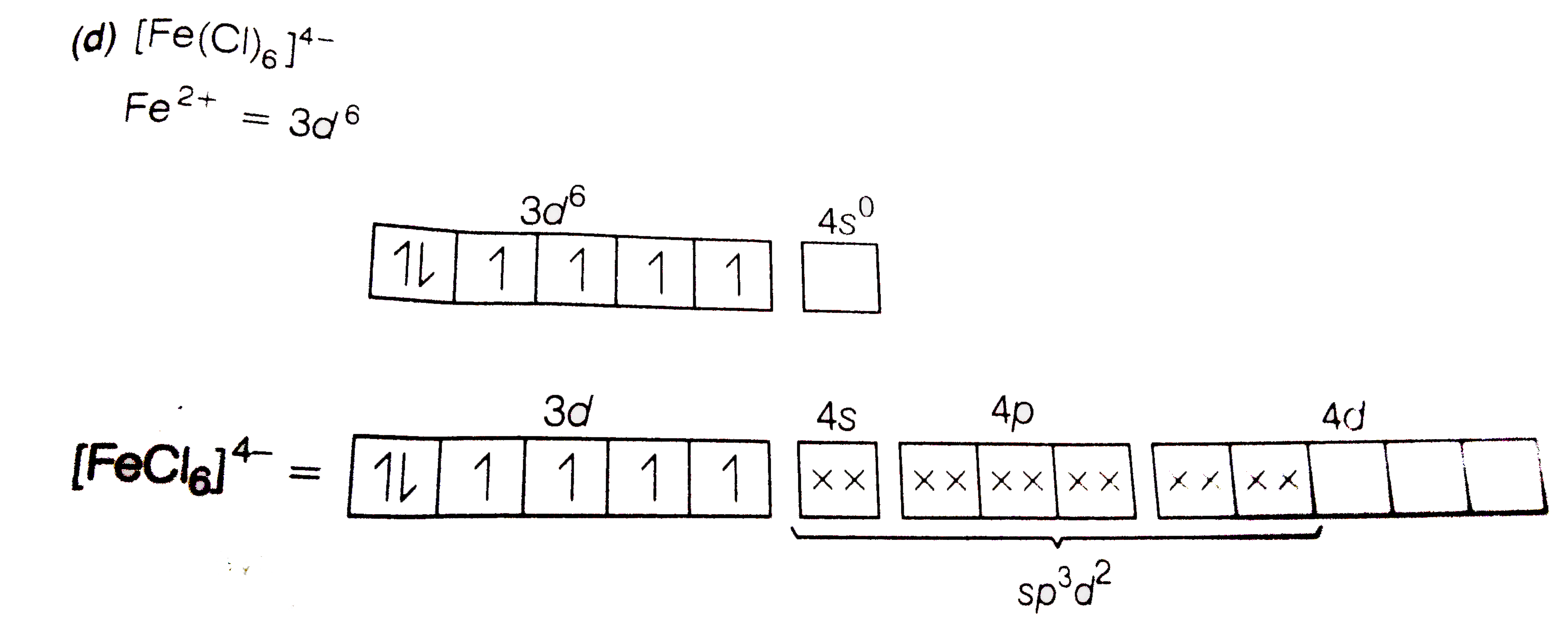Using valence bond theory, explain the following in relation to the complexes given below
[Mn(CN)6]3−,[Co(NH3)6]3+,[Cr(H2O)6]3+,[FeCl6]4−
(a) type of hybridisation
(b) Inner or outer orbital complex
(c) Magnetic behaviour
(d) Spin only magnetic moment value.
(a) [Mn(CN)6]3−
[Mn3+=3d4

(i) d2sp3 hybridisation
(ii) Inner orbital complex because (n−1)d-orbitals are used.
(iii) Paramagnetic moment (μ)=√2(2+2)=√8=2.82BM
(iv) Spin only magnetic moment (μ)=√2(2+2)=√8=2.82BM
(b) [Co(NH3)6]3+
CO3+=3d64s0

(NH3 pair up the unpaired 3d electons.)
(i) d2sp3 hybridisation
(ii) Inner orbital complex because of the involvement of (n−1) d-orbital in bonding.
(iii) Diamagnetic, as no unpaired electron is present.
(iv) μ=√n(n+2)=√0(0+2)=0(Zero)
(c) [Cr(H2O)6]3+

(i) d2sp3 hybridisation
(ii) Inner orbital complex (as (n−1) d-orbital take part.)
(iii) Paramagnetic (as three unpaired electrons are present.)
(iv) μ=√n(n+2)=√3(3+2)=√15=3.87BM
(d) [Fe(Cl)6]4−
Fe2+=3d6

(i) sp3d2 hybridisation
(ii) Outer orbital complex because nd-orbitals are involved in hybridisation.
(iii) Paramagnetic (because of the presence of four unpaired electrons).
(iv) μ=√n(n+2)=√4(4+2)=√24=4.9BM
Topper's Solved these Questions
Similar Questions
Using valence bond theory, explain the following in relation to the complexes given below
[Mn(CN)6]3−,[Co(NH3)6]3+,[Cr(H2O)6]3+,[FeCl6]4−
(a) Type of hybridisation.
(b) Inner or outer orbital complex.
(c) Magnetic behaviour.
(d) Spin only magnetic moment value.View SolutionAmongst the following , the most stable complex is :
(a) [Fe(H2O)6]3+ (b) [Fe(NH3)6]3+ (c) [Fe(C2O4)3]3− (d) [FeCl6]3− .View Solution
Knowledge Check
- Question 1 - Select One
The magnetic moment of complex given below are in the order:
(I) [Ni(CO)4]
(II) [Mn(CN)6]4−
(III) [Cr(NH3)6]3+
(IV) [CoF6]3−AIgtIIgtIIIgtIVBI<II<III<IVCIVtII>I>IIIDIV<II<I<III - Question 2 - Select One
The magnetic moment of complex given below are in the order:
(I) [Ni(CO)4]
(II) [Mn(CN)6]4−
(III) [Cr(NH3)6]3+
(IV) [CoF6]3−AIgtIIgtIIIgtIVBI<II<III<IVCIVtII>I>IIIDIV<II<I<III - Question 3 - Select One
Consider the following complex ions.
[CrCl6]3− [Cr(H2O)6]3+
[Cr(NH3)6]3+ [Cr(CN)6]3−
The correct order of △0 is :AP>Q>R>SBP<R<Q<SCP<Q<R<SDP<Q<S<R
One the basis of VBT answer the following complex ions
(i) [Ti(bpy)3]Θ
(b) [V(H2O)6]3+
(ii) [V(H2O)6]3+
(III) [Mn(CN)6]4−
[Mn(CN)6)]3−
(V) [Ir(NH3)6]3+ .
Type of hybridisation involed
(b) Type of inner or outer orbital octahedral complex
(c ) Magnetic behaviour and μsπn value .View SolutionGiven complexes are low spin complexes [V(CN)6]4− [Cr(NH3)6]3+ [Ru(NH3)6]3+ [Fe(CN)6]4− Then of magnetic (μ) for V2+,Fe2+,Cr3+,Ru3+ is
View SolutionThe magnetic moment of a complex ion is 2.83BM The complex ion is
[Cr(H2)O)6]3+
(b) [Cu(CN)6]2−
(c ) [V(H2O))6]3+
(d) [MnCI4]2− .View SolutionConsider the following complex ions.
[CrCl6]3− [Cr(H2O)6]3+
[Cr(NH3)6]3+ [Cr(CN)6]3−
The correct order of Δ0 is :View SolutionIn the complex [Fe(H2O)6]3+ [Fe(CN)6]3− [Fe(C2O4)3]3− and [FeCl6]3−, that complex that has highest stability is
View Solution

